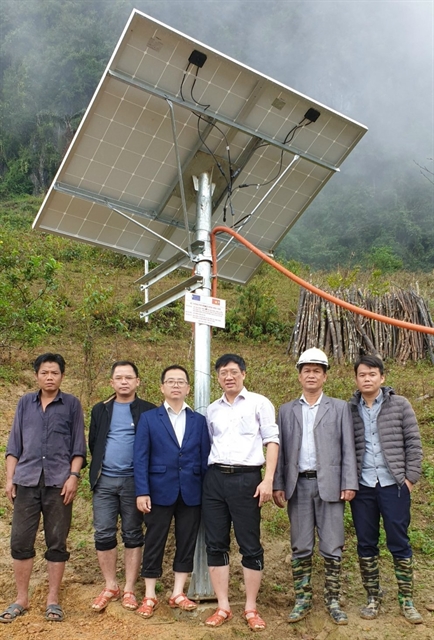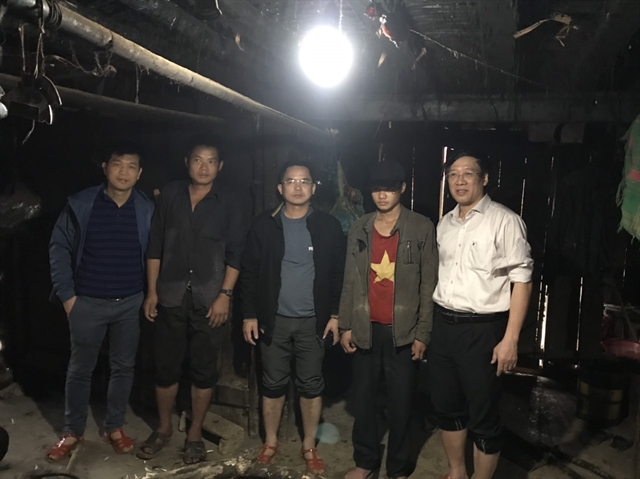 Society
Society


|
| Deputy head of the Division of Grid and Rural Electricity under the MOIT Lưu Tùng Giang (third, right) in a field trip to Cao Bằng Province. — Photo courtesy of Lưu Tùng Giang |
According to the Ministry of Industry and Trade (MOIT), all communes across Việt Nam had access to electricity by the end of 2020. In 2016-2020, more than 204,700 households got connected to the grid. The country has set a target to give all rural households access to electricity by 2025.
Deputy head of the Division of Grid and Rural Electricity under the MOIT Lưu Tùng Giang talks to Vân Nguyễn about the power supply programme and the prospects of using renewable energy in off-grid communities
According to the MOIT, there were 153,911 households in Việt Nam living without electricity as of last year. Where are they located and what are the characteristics of these areas?
The target programme for power supply in rural, mountainous and island areas for 2016 – 2020 aims to contribute to poverty reduction, enhance locals’ lives, contribute to social equality and security and contribute to the maintenance of political security and social order, among others. One of its targets was to provide grid electricity for 1,055,000 households and provide electricity from renewable energy sources for 21,000 households.
During this period, 204,737 households in 3,079 villages of 1,107 communes, accounting for 19 per cent of the target, were provided with grid power.
All five targeted islands of Lý Sơn, Bạch Long Vỹ, Nhơn Châu, Cù Lao Chàm, and Trần and Cái Chiên also got access to electricity under this programme.
The number of households living without electricity and with a disrupted and unstable source of electricity is 153,911 and 717,352, respectively. They are mostly located in mountainous, border provinces in the northern region including Hà Giang, Điện Biên, Sơn La, Cao Bằng, Lào Cai, Yên Bái and Lai Châu provinces, as well as some central provinces such as Thanh Hóa, Nghệ An and Kiên Giang.
These areas are sparsely populated, far from the national grid and have complex geographical features.
What difficulties are hindering efforts to give 100 per cent of rural households access to power and how will this be addressed in the next five years to achieve this target by 2025?
The total investment needed for the power supply programme is VNĐ30.1 trillion (US$1.3 billion) with 85 per cent of it from the State budget and the rest from reciprocal capital from local and Vietnam Electricity (EVN) budgets.
The biggest difficulty for this programme is the lack of resources. The State budget allocated for this programme is about VNĐ4.7 trillion, accounting for 18.5 per cent of the target.
While the State budget is limited, remote areas and poor infrastructure here make grid extension costs even higher.
To achieve the target, the Department of Electricity and Renewable Energy, the advisory agency of the MOIT, is developing a national target programme with proposals for sustainable solutions that incorporate both the State budget and private investment.
We are proposing to allocate investment based on specific areas. Priority will be given to areas where private investment is most likely, then for areas that don’t have access to electricity, and then areas that have access to electricity but the source of electricity is disrupted and not stable.
In recent years, Việt Nam has witnessed a boom in renewable energy development. How have these sources of energy been used in off-grid areas?
The MOIT piloted a solar energy project in nine communes of three districts in Cao Bằng Province, an area with low solar radiation levels, from 2018-2020. People in these localities are ethnic minority groups who are mostly of the Mông group. The area is sparsely populated and many people live close to the border.

|
| A local ethnic household in Cao Bằng Province have electricity from solar sources. — Photo courtesy of Lưu Tùng Giang |
The total investment for this project was about VNĐ58.8 billion. By the end of 2020, a total of 617 households had received access to electricity from solar sources under this project.
This was the only renewable energy project implemented in off-grid areas in 2016-2020. Cao Bằng has much lower solar radiation than localities in the central and southern regions of Việt Nam, however, as per the inspection results of the MOIT as of November last year, this solar panel model can serve a household very well. Each household can use a fan, a television and two LED lights for 12 hours a day.
What are the prospects for using renewable energy in these areas?
The investment for renewable energy in off-grid areas is lower than the grid. A solar panel system for a household in Cao Bằng costs about VNĐ100 million ($4,350) while the cost for grid extension here ranges from VNĐ200-400 million depending on the location. Renewable energy is also suitable for these areas where locals use a small amount of electricity.
However, there are difficulties in the management of State property. The equipment will be treated as State property and managed by the local commune or district, not the EVN. There would need to be a team to do operation and maintenance work. So this is an additional task for the locality and there is no mechanism available to handle violations if they fail to comply with the regulations.
In addition, the use of electricity in these areas is small and the sparsely populated, divided geographic conditions make it hard to collect electricity bills.
Based on this project’s results, we will work on a suitable mechanism for privatisation, not to expand this model. Our target is to provide a sustainable source of electricity for not only households’ use but also production activities. For example, we may develop a concentrated system using both solar, wind energy and hydropower. Solar is used for daytime and wind for nighttime. Households can invest in this system and even sell extra power to the EVN. — VNS